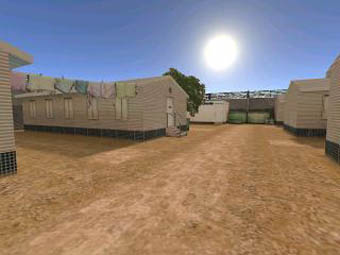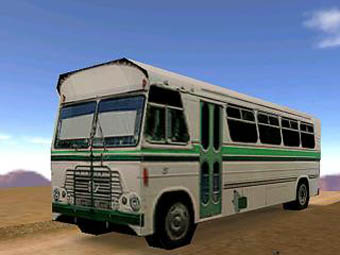The meme game: Escape from Woomera
Melanie Swalwell

Escape from Woomera
It made the front page of the Sydney Morning Herald: “Escape game wires the minister” (April 30, 2003). You’ve probably heard about Escape from Woomera (EFW), the new Australian game being developed with funding from the Australia Council for the Arts. Needless to say, Immigration Minister Philip Ruddock is less than impressed about the project, which recreates 4 detention centres, including the now mothballed but infamous Woomera, for players to escape from. He and Arts Minister Rod Kemp have been highly critical of the Australia Council’s decision to award $25,000 in development funding to the Melbourne-based team, with Kemp demanding an urgent explanation from the Council. Chairman of the New Media Arts Board, Michael Snelling, told the media that while he was aware the project could be controversial, the application had ranked competitively and met all the criteria.
Ruddock’s main claim is that the game will promote unlawful behaviour, and support for his position came from unlikely directions. Some refugee advocates were keen to denounce the project, claiming it “trivialised the plight of asylum-seekers”, and was “tasteless”. And Human Rights Commissioner, Sev Ozdowski, issued a press release calling the project “at best…insensitive.” At least one refugee spokesperson took a different view, welcoming the Council’s support for any project that highlights the horrors of mandatory detention.

Escape from Woomera
These quick opinion grabs, framed adversarially by the news media, conceal much that is of interest about this project. A significant cultural intervention, its complexities should give us pause. EFW is the first computer game in this country to tackle such a contentious issue. And while a few games elsewhere comment on important politics (the Syrian intifada game Under Ash being a notable example), this project has the potential to transform the way we think about games.
Computer games possess a rare capacity for mobilising public anxiety, so it’s unsurprising that some have reservations about the project. But what needs to be understood is that, far from constituting training for ‘real life’ actions, computer games enable players to do things that they can’t do in ‘real life’. Players report that this is one of the things that makes playing a game enjoyable. Claims that EFW will encourage detainees to break out, jeopardising their chances of a visa, or that the project characterises them as criminals trying to “bust out of jail [sic]”, as Ozdowski puts it, largely miss the point. Rather than being a game ridiculing the situation of detainees, EFW will enable those who are unlikely to ever get inside a detention centre, to imagine themselves there. Virtually recreating these sites elegantly undermines their ‘no go’ status, simultaneously shrinking the space between ‘us’ and ‘them’. As Julian Oliver, one of the EFW team says:
[This] is something that we’re in a kind of public detention from, we don’t have access to Woomera, let alone its insides. Woomera, and detention centres like it, are not only strategically isolated to ensure they’re harder to escape, but also to ensure the public will forget it’s even there…The inherent tension within this situation, in the country that you’re standing on, [is that] you don’t have access to this stuff. EFW is all about taking a highly representative impression of life in a detention centre, mobilising it throughout public networks, and installing it onto people’s desktop computers inside their homes. Games are an ideal medium to engage with this kind of content… because to play is to become a subject of the content.EFW is, therefore, an exciting project with a bold vision. It is edgy because it addresses one of the most divisive issues that citizens of Australia have faced in recent years: the governments’ detention of refugees in their name. The game will not be everyone’s cup of tea, but as it is planned to offer the game for free download over the internet, no one need play unless they want to.
To equate the playfulness of this project with triviality, as some have done, is a mistake. Like humour, play is anything but lightweight: play is important because it enables that which has become stale, old news, a source of anxiety even, to be reapproached. In playing a game, one partially leaves behind the workaday world and its competitive pressures—to ‘keep up’ and ‘get ahead’. Play enables different engagements and encounters, making it possible to envisage things being otherwise.
In inviting us to play at escaping from Woomera, then, the makers of this game are returning something precious to us, namely agency. Amidst the government double-speak and blaming, where enough seeds of doubt are sown (about asylum-seekers’ motives, backgrounds, health and wealth) so we never really know quite what to think, EFW offers action, for players to actively experiment with what it’s possible to do and be, in a game. Making a game that enables players to seize some initiative in relation to the refugee question is significant.
The EFW team knows it takes more than a good idea to make a great game. While their credentials as refugee activists have received attention in the mainstream press, their expertise in game design and development is arguably as important to the final product. Gamers are astute judges of interactivity, and any game that sacrificed gameplay for an earnest political message simply would not cut it. Between them, the EFW team has many years experience in the commercial games industry, including work on the biggest budget Australian game for international release. Other credits include public art commissions and work on the popular ABC satire CNNNN. The main assembled team includes Mark Angeli, Julian Oliver, Ian Malcolm, Stephen Honegger, Kate Wild and Morgan Simpson. Rather than trying to offer solutions to mandatory detention, the team’s focus is, as one member puts it, on asking “what are the great game elements about these stories, and trying to make a game out of those, rather than actually try to present all the information and points of view.”
With all the controversy over this particular game and its content, it is easy to lose sight of the significance of this project receiving Australia Council support. Many already recognise that as a medium, games are ripe for artistic experimentation. But this funding indicates that the New Media Arts Board also recognises the maturing of games as a medium, and the significant potential of games for contemporary art.
The release of a playable demo of the EFW game is still some 6 months off. But the importance of this project is already becoming apparent. Since it hit the headlines there has been an amazing degree of discussion of the project. Apart from postings on gaming message boards, pro-refugee e-lists, and games industry news sites, EFW has made it into classrooms, onto TV comedy shows, and, significantly, onto talkback radio. Over the space of a few weeks, it has become a powerful meme, a concept for thinking with—about refugees, their detention, and the humourless state of current politics in this country. Evidence that it has fired imaginations is contained in the witty suggestions for sequels, posted to newspapers: Escape from Nauru and Manus Island and Escape from Camp X-Ray.
We might not have known it, but we needed an Escape From Woomera. It broadens the field of what can be said, thought, and felt about Woomera, refugees and detention. That is where the art lies. That it also leaves Ruddock spluttering with indignation is icing on the cake.
–
RealTime issue #55 June-July 2003 pg. 24






